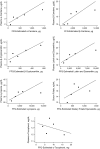Biochemical validation of food frequency questionnaire-estimated carotenoid, alpha-tocopherol, and folate intakes among African Americans and non-Hispanic Whites in the Southern Community Cohort Study
- PMID: 20061366
- PMCID: PMC2842194
- DOI: 10.1093/aje/kwp402
Biochemical validation of food frequency questionnaire-estimated carotenoid, alpha-tocopherol, and folate intakes among African Americans and non-Hispanic Whites in the Southern Community Cohort Study
Abstract
Few food frequency questionnaires (FFQs) have been developed specifically for use among African Americans, and reports of FFQ performance among African Americans or low-income groups assessed using biochemical indicators are scarce. The authors conducted a validation study within the Southern Community Cohort Study to evaluate FFQ-estimated intakes of alpha-carotene, beta-carotene, beta-cryptoxanthin, lutein/zeaxanthin, lycopene, folate, and alpha-tocopherol in relation to blood levels of these nutrients. Included were 255 nonsmoking participants (125 African Americans, 130 non-Hispanic whites) who provided a blood sample at the time of study enrollment and FFQ administration in 2002-2004. Levels of biochemical indicators of each micronutrient (alpha-tocopherol among women only) significantly increased with increasing FFQ-estimated intake (adjusted correlation coefficients: alpha-carotene, 0.35; beta-carotene, 0.28; beta-cryptoxanthin, 0.35; lutein/zeaxanthin, 0.28; lycopene, 0.15; folate, 0.26; alpha-tocopherol, 0.26 among women; all P's < 0.05). Subjects in the top decile of FFQ intake had blood levels that were 27% (lycopene) to 178% (beta-cryptoxanthin) higher than those of subjects in the lowest decile. Satisfactory FFQ performance was noted even for participants with less than a high school education. Some variation was noted in the FFQ's ability to predict blood levels for subgroups defined by race, sex, and other characteristics, but overall the Southern Community Cohort Study FFQ appears to generate useful dietary exposure rankings in the cohort.
Figures

Similar articles
-
Validation of a food frequency questionnaire measurement of selected nutrients using biological markers in African-American men.Eur J Clin Nutr. 2007 Nov;61(11):1328-36. doi: 10.1038/sj.ejcn.1602641. Epub 2007 Feb 7. Eur J Clin Nutr. 2007. PMID: 17299490
-
Reproducibility and validity of a food frequency questionnaire among pregnant women in a Mediterranean area.Nutr J. 2013 Feb 19;12:26. doi: 10.1186/1475-2891-12-26. Nutr J. 2013. PMID: 23421854 Free PMC article.
-
The assessment of dietary carotenoid intake of the Cardio-Med FFQ using food records and biomarkers in an Australian cardiology cohort: a pilot validation.J Nutr Sci. 2024 Apr 11;13:e20. doi: 10.1017/jns.2024.6. eCollection 2024. J Nutr Sci. 2024. PMID: 38618284 Free PMC article.
-
Racial differences in correlations between reported dietary intakes of carotenoids and their concentration biomarkers.Am J Clin Nutr. 2011 May;93(5):1102-8. doi: 10.3945/ajcn.110.010322. Epub 2011 Mar 9. Am J Clin Nutr. 2011. PMID: 21389177 Free PMC article.
-
Comparing biological measurements of vitamin C, folate, alpha-tocopherol and carotene with 24-hour dietary recall information in nonhispanic blacks and whites.Ann Epidemiol. 2001 Aug;11(6):406-16. doi: 10.1016/s1047-2797(01)00224-1. Ann Epidemiol. 2001. PMID: 11454500
Cited by
-
A Taiwanese food frequency questionnaire correlates with plasma docosahexaenoic acid but not with plasma eicosapentaenoic acid levels: questionnaires and plasma biomarkers.BMC Med Res Methodol. 2013 Feb 16;13:23. doi: 10.1186/1471-2288-13-23. BMC Med Res Methodol. 2013. PMID: 23414574 Free PMC article.
-
Assessing vitamin status in large population surveys by measuring biomarkers and dietary intake - two case studies: folate and vitamin D.Food Nutr Res. 2012;56. doi: 10.3402/fnr.v56i0.5944. Epub 2012 Apr 2. Food Nutr Res. 2012. PMID: 22489219 Free PMC article.
-
Associations of 24 h urinary excretions of α- and γ-carboxyethyl hydroxychroman with plasma α- and γ-tocopherol and dietary vitamin E intake in older adults: the Lifelines-MINUTHE Study.Eur J Nutr. 2022 Oct;61(7):3755-3765. doi: 10.1007/s00394-022-02918-8. Epub 2022 Jun 19. Eur J Nutr. 2022. PMID: 35718823 Free PMC article.
-
Sociocultural Factors, Access to Healthcare, and Lifestyle: Multifactorial Indicators in Association with Colorectal Cancer Risk.Cancer Prev Res (Phila). 2022 Sep 1;15(9):595-603. doi: 10.1158/1940-6207.CAPR-22-0090. Cancer Prev Res (Phila). 2022. PMID: 35609123 Free PMC article.
-
Diet Quality and Nutrient Intake of Urban Overweight and Obese Primarily African American Older Adults with Osteoarthritis.Nutrients. 2018 Apr 13;10(4):485. doi: 10.3390/nu10040485. Nutrients. 2018. PMID: 29652820 Free PMC article.
References
-
- International Agency for Research on Cancer. Fruits and Vegetables. (IARC Handbooks of Cancer Prevention, vol 8) Lyon, France: IARC Press; 2003.
-
- Mente A, de Koning L, Shannon HS, et al. A systematic review of the evidence supporting a causal link between dietary factors and coronary heart disease. Arch Intern Med. 2009;169(7):659–669. - PubMed
-
- Bruckdorfer KR. Antioxidants and CVD. Proc Nutr Soc. 2008;67(2):214–222. - PubMed
-
- Sankaranarayanan R, Mathew B. Retinoids as cancer-preventive agents. IARC Sci Publ. 1996;(139):47–59. - PubMed
-
- McNulty H, Pentieva K, Hoey L, et al. Homocysteine, B-vitamins and CVD. Proc Nutr Soc. 2008;67(2):232–237. - PubMed
Publication types
MeSH terms
Substances
Grants and funding
LinkOut - more resources
Full Text Sources
Medical

